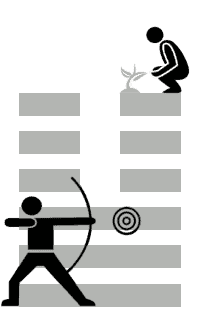— Anagarika, Govinda. 1983. Die innere Struktur des I-Ging. Freiburg im Breisgau: Aurum.
— Bordt, Michael. 2017. Die Kunst, die Eltern zu enttäuschen: Vom Mut zum selbstbestimmten Leben. München: Elisabeth Sandmann Verlag.
— Bordt, Michael. 2018. Die Kunst, sich selbst zu verstehen Den Weg ins eigene Leben finden. Ein philosophisches Plädoyer. 1. Auflage. München: Elisabeth Sandmann Verlag.
— Brodde, August. 1976. Ratschläge für den Akupunkteur. Pflaum.
— Clarke, J. J. 1997. C. G. Jung und der östliche Weg. Zürich: Walter.
— Connelly, Dianne M. 1995. Traditionelle Akupunktur: Das Gesetz der Fünf Elemente. Heidelberg: Endrich.
— Dsi, Dschuang. n.d. “True Scripture of Southern Florescence.” http://ctext.org/zhuangzi/nourishing-the-lord-of-life.
— Dsi, Dschuang. 1986. Das wahre Buch vom südlichen Blütenland. Translated by Richard Wilhelm. Köln: Diederichs.
— Fiedeler, Frank. 1996. Yijing. München: Diederichs.
— Frick, Eckhard. 2015. Psychosomatische Anthropologie. Stuttgart: Kohlhammer.
— Hammer, Leon. 2000. Psychologie & Chinesische Medizin: Zukunftsweisende Erkenntnisse über das energetische Zusammenspiel von Emotionen und Körperfunktionen. Sulzberg: Joy-Verl.
— Hertzer, Dominique. 1996. Das alte und das neue Yijing. Die Wandlungen des Buches der Wandlungen. München: Diederichs.
— Hertzer, Dominique. 1996. Das Mawangdui-Yijing. Text und Deutung. München: Diederichs.
— Hicks, Angela. 2008. Konstitutionelle Akupunktur nach den Fünf Wandlungsphasen; München ; Jena: Elsevier, Urban & Fischer.
— Hicks, Angela, John Hicks, and Peter Mole. 2008. Konstitutionelle Akupunktur nach den Fünf Wandlungsphasen. München: Urban & Fischer Verlag.
— Kaatz, Debra. 2005. Characters of Wisdom: Taoist Tales of the Acupuncture Points. The Petite Bergerie Press.
— Kaatz, Debra. 2009. Receiving Spirit: The Practice of Five Element Acupuncture. The Petite Bergerie Press.
— Lorenzen, Udo. 2000. Die Wandlungsphasen der Traditionellen Chinesischen Medizin: Wasser. 5 Wasser. München: Müller & Steinicke.
— Lorenzen, Udo. 1996. Die Wandlungsphasen der Traditionellen Chinesischen Medizin: Erde. 3 Erde. München: Müller & Steinicke.
— Lorenzen, Udo. 1998. Die Wandlungsphasen der Traditionellen Chinesischen Medizin: Feuer. 4 Feuer. München: Müller & Steinicke.
— Lorenzen, Udo. 1994. Die Wandlungsphasen der Traditionellen Chinesischen Medizin: Metall. 2 Metall. München: Müller & Steinicke.
— Lorenzen, Udo. 2002. Die Wandlungsphasen der Traditionellen Chinesischen Medizin: Holz. 1 Holz. München: Müller und Steinicke.
— Lowenthal, Wolfe. 1997. An der Pforte zum Wunderbaren. Hamburg: Kolibri.
— Lowenthal, Wolfe. 1997. Es gibt keine Geheimnisse. Hamburg: Kolibri.
— Möller, Hans-Georg. 2010. In der Mitte des Kreises. Daoistisches Denken. Berlin: Verlag der Weltreligionen im Insel Verlag.
— Ni, Maoshing. 2008. “Der Gelbe Kaiser”: Das Grundlagenwerk der Traditionellen Chinesischen Medizin. Fischer-Taschenbuch-Verlag.
— Porkert, Manfred. 1986. Die chinesische Medizin. Düsseldorf: Econ.
— Rogers, Carl R. 2016. Entwicklung der Persönlichkeit: Psychotherapie aus der Sicht eines Therapeuten. Translated by Jacqueline Giere. Stuttgart: Klett-Cotta.
— Schmid, Martin. 2002. Taiji – Die Innere Kraft von Himmel und Erde. Ahlerstedt: Param.
— Vogelsang, Kai. 2012. Geschichte Chinas. Stuttgart: Reclam.
— Watts, Alan. 1983. Der Lauf des Wassers. Berlin: Suhrkamp.
— Wilhelm, Richard. 1989. I Ging. Das Buch der Wandlungen. München: Diederichs.
— Wilhelm, Richard. 1989. I Ching or Book of Changes. Harmondsworth: Penguin.
— Worsley, J. R. 1994. Akupunktur. Heilung für Dich. Neue Erde.
— Worsley, J. R. 2000. Was Ist Akupunktur?: Gesundheit für den ganzen Menschen. Neue Erde.
— Zimmermann, Georg. 2007. I Ging – Das Buch der Wandlungen. Düsseldorf: Patmos.
— Zimmermann, Georg. 2003. I Ging. Diederichs Kompakt. Kreuzlingen: Hugendubel.
Translations: by the author



